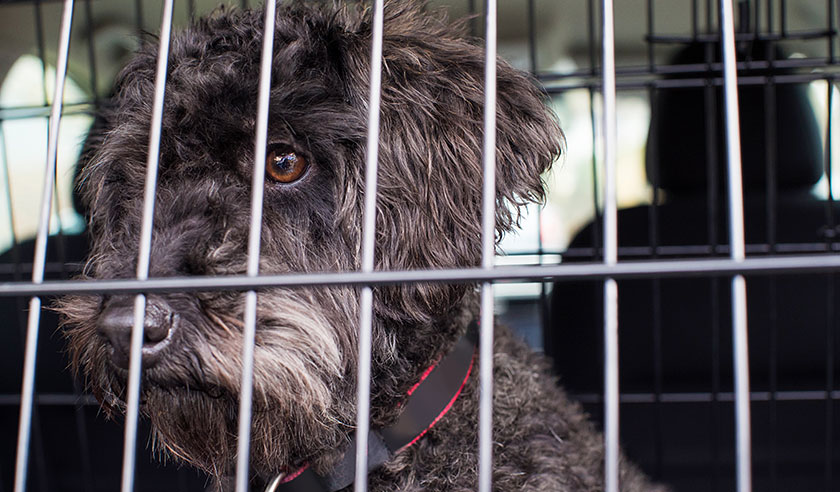Ideally, your dog (and you) will never have to cross paths with a snake. But it happens. Approximately 150,000 dogs and cats are bitten by venomous snakes each year in the United States[1], and bites from nonvenomous snakes are thought to be even more common. It’s important to know how to identify and treat snake bites and, more importantly, how to avoid them altogether.

How Do You Know Your Dog Has Been Bitten by a Snake?
If you saw the bite happen, try and get a glimpse or even a photo of the snake from a safe distance. Do not put yourself in danger. Identifying the snake or being able to describe its appearance can help with treatment and ease your worry if it turns out to be nonvenomous. But it’s not worth risking a bite yourself.
If you didn’t see the bite, you might instead see snake bite symptoms like the following:
Non-Venomous Snake Bite Symptoms
Typically, there will be swelling and bruising in the area around the bite. You may be able to see a pair of puncture wounds created by the fangs. The bite site is normally very painful. Do not attempt to touch or probe the bite site as your dog might react painfully.
Venomous Snake Bite Symptoms
The symptoms are dependent on the species of snake. But the following can help you determine if the snake was poisonous.
- Swelling will be significant and spread quickly.
- The bite wound will tend to bleed, or there will be bloody discharge.
- You may not see puncture wounds due to the rapid swelling or the smaller fangs of some snakes.
- It’s also good to note that there are times when a venomous snake will “dry bite.” This means they bite but do not release venom. It can be difficult to determine when a dry bite has occurred, and it should always be assumed that venom was present in the bite.
What to Do Immediately After Your Dog Is Bitten by a Snake
Regardless of the apparent severity of the bite or whether the snake was poisonous you should get your dog to a veterinarian for evaluation and care. The presence of venom can cause immediate and significant risk to your dog’s body. In addition to that, snake bites are wounds, and a snake’s mouth is teeming with bacteria. Proper care is vital to ensure the wound does not become infected. Bite wounds are also very painful, and your dog will need appropriate pain management. Even if a snake is non-venomous, the swelling from the snake bite can be fatal to your dog.
Serious, life-threatening signs require an immediate visit to an emergency veterinary clinic and can include if your dog:
- Appears normal at first but suddenly becomes weak and collapses
- Is lethargic
- Has muscle tremors
- Has dilated pupils
- Starts vomiting and/or has diarrhea
- Has bloody urine
- Is drooling or has excessive salivation
- Is bleeding from the mouth, nose, or site of the bite
- Is unable to control urination or bowel movements
- Shows any signs of paralysis
If you can’t get to a veterinarian immediately, there are a few things you should do while you’re trying to get in touch with your veterinarian or the nearest animal emergency clinic.
- Remain calm. It is a stressful situation all around but staying clear-headed will help you take the appropriate next steps and will help manage your dog’s stress level, as well.
- Keep your dog quiet, calm, and warm.
- If possible, depending on the location of the bite wound, keep it below the level of the heart — this can help slow the venom from spreading throughout the body.
- If possible, carry your dog rather than allowing them to walk on their own.
Treating A Snakebite on a Dog (You Can’t Do This at Home)
Bites that aren’t serious or venomous can be treated by your veterinarian as a puncture wound. Treatments will be determined by your veterinarian based on the location and type of snake bite.
Venomous bite treatment is determined by the type of snake and severity of the wound and tissue damage. The generalized course of treatment addresses the symptoms of shock, low blood pressure, and infection. If there’s evidence of respiratory distress, that is addressed as well. Normally, dogs are hospitalized for at least one to several days. It’s then advised to restrict activity and let them rest for one to two weeks.
Treatments administered to treat snake bites can include:
- Intravenous (IV) fluids to address circulation problems and low blood pressure. IV fluids sometimes need to be given as a rapid infusion.
- Antibiotics to treat bacterial infection.
- Pain medications to control pain and discomfort.
- Antivenom to directly counteract the effects of venom. This can be critical in bites from some types of snake.
- Blood product transfusion to address blood clotting or significant bleeding resulting from the venom’s effects.
Tips to Avoid Snakes (and Snake Bites) With Your Dog
Try to avoid tall grasses and piles of leaves, rocks, and wood, as these are all places where snakes can easily hide. When hiking, stay on trails and keep an eye on the ground so you and your dog don’t step right on one.
You can train your dog to avoid snakes using positive reinforcement; aversive snake avoidance training methods such as shock collars are not appropriate and may actually increase the danger during snake encounters. It’s amazing to see the results of positive reinforcement snake avoidance training. Having a solid “leave it” or other diversion cue in place allows you to turn your dog’s attention away from a potential danger like a snake in the path. A certified professional dog trainer can help you establish a strong training foundation and incorporate these techniques into your daily routine.
ZPC-01288R1
- Peterson M, Meerdink G: Venomous bites and stings, in Kirk R (ed): Current Veterinary Therapy X. Philadelphia, WB Saunders, 1989; pp 177-186.





